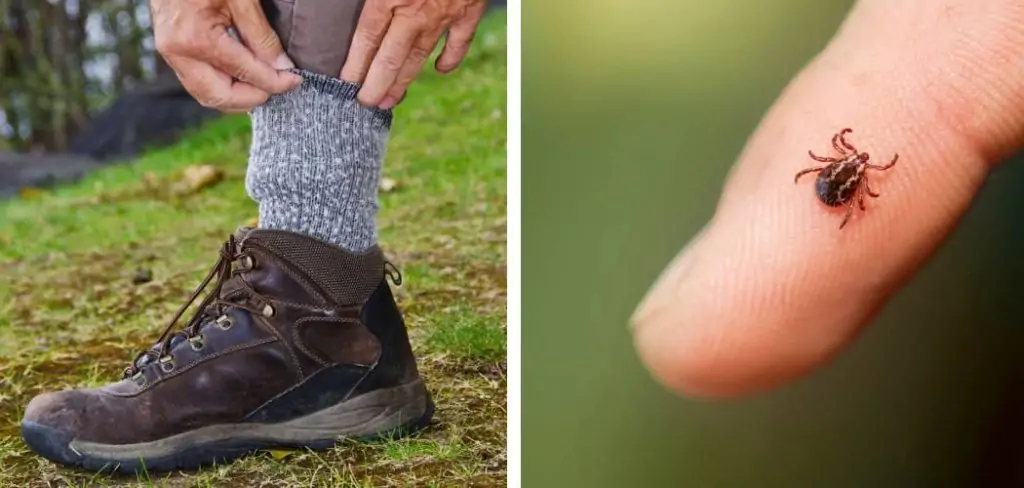Hiking is a great activity that allows you to connect with nature and challenge yourself physically. However, ticks can be a problem when hiking, especially during the summer months. Ticks are small insects that feed on blood from animals including humans. They can carry diseases such as Lyme disease, which can be harmful to your health.
Here are some tips on how to avoid ticks while hiking.

How to Remove a Tick Safely
If you do find a tick on your skin, it is important to remove it properly and as soon as possible. The longer the tick stays attached, the greater the chance of disease transmission.
- Use tweezers or a specialized tick removal tool to grasp the tick as close to the skin as possible.
- Gently pull upwards with steady pressure until the tick releases its hold on the skin.
- Clean the bite area and your hands with rubbing alcohol or soap and water.
- Dispose of the tick by flushing it down the toilet or placing it in a sealed bag/container.
- Keep an eye on the bite for any signs of infection such as redness, swelling, or a bull’s eye rash.
7 Tips on How to Avoid Ticks While Hiking
Tips 1: Wear Protective Clothing
Hiking is one of the most enjoyable outdoor activities that we can do to stay active and explore the beauty of nature. While it’s an excellent way to clear the mind and get some exercise, it’s also important to keep in mind that there are risks associated with it. One of the most significant risks – especially during the summer months – is the presence of ticks. Ticks can transmit diseases such as Lyme disease and Rocky Mountain spotted fever, so it’s important to know how to avoid them.
One straightforward way to reduce the risk of getting a tick bite while hiking is to wear protective clothing. This includes long-sleeved shirts, long pants, and closed-toe shoes. Additionally, you may consider tucking your shirt into your pants and your pant legs into your socks to prevent ticks from crawling up your legs. By following these recommendations, you can limit your exposure to ticks and keep yourself protected while on the trail.

Tips 2: Use Insect Repellent
When you’re out on a hike in nature, one of the biggest concerns you may face is the threat of ticks. These tiny parasites can cause a lot of problems for humans, including Lyme disease and other illnesses. Fortunately, there are several steps you can take to help protect yourself from ticks while hiking. One of the most effective methods is to use insect repellent. By applying this product to your exposed skin and clothing, you can create a barrier between yourself and the ticks.
Look for an insect repellent that contains DEET (N, N-Diethyl-meta-toluamide), which has been proven to be the most effective against ticks. Remember to reapply the repellent according to the product’s instructions to ensure maximum protection. By taking this simple step, you can enjoy your time in nature without having to worry about tick bites.
Tips 3: Stick to the Center of the Trails
Tick season is upon us and hikers everywhere are looking for ways to protect themselves from these nasty little bugs. One of the best ways to avoid ticks while hiking is by sticking to the center of the trails. It may be tempting to stray from the path to explore, but venturing into tall grass or woody areas can put you at risk for tick bites. Ticks like to hang out in areas of low-hanging vegetation, waiting for a host to pass by. By staying in the middle of the trail, you minimize your risk of coming into contact with these bloodsuckers and can enjoy your hike without worry. Remember to wear light-colored clothing, use tick repellent, and do a thorough tick check after your hike to stay tick-free!
Tips 4: Check Yourself and Others for Ticks
One of the most critical things to do to avoid ticks while hiking is to check yourself and others for parasitic insects. As per experts, ticks can carry various diseases, and early detection of a tick bite is essential to prevent the spread of the disease. These tiny creatures can conceal themselves in hard-to-see places on your body or clothes, so it’s crucial to check your entire body for any ticks that might have fallen on you while walking. Checking yourself, friends, and family members can help identify any ticks early and take immediate action to avoid them. Remember, prevention is key, and it is essential to be vigilant and check yourself for tick bites regularly.
Tips 5: Shower After Hiking
Ticks are a common concern for hikers, but there are simple steps you can take to avoid them. One effective strategy is to shower after your hike. This is because ticks can quickly latch onto your clothing and skin during your outdoor adventure, and a shower can help remove any lingering ticks. It’s important to thoroughly check your entire body, particularly around your hairline, underarms, and groin area, for any ticks that may have attached themselves. Remember that ticks can carry serious diseases such as Lyme disease, so taking preventive measures is crucial for your safety. By showering after your hike, you can decrease the chances of a possible tick bite.

Tips 6: Wash Your Clothes
When planning a hiking excursion, it’s important to take precautions to avoid ticks. These little bugs can carry harmful diseases like Lyme disease, so it’s crucial to know how to protect yourself. One easy step you can take is to wash your clothes before heading out on a hike. Ticks are attracted to the carbon dioxide we release when we breathe, but they are even more attracted to dirty clothes. Washing your clothes in hot water and drying them on high heat can eliminate any ticks or eggs that may be hiding in the fabric. This simple step can make a big difference in keeping ticks away while you enjoy the great outdoors.
Tips 7: Know How to Remove a Tick Properly
As an avid hiker, you understand the importance of preparation before hitting the trails. One of the most crucial aspects to consider when taking a hike is tick prevention. These tiny parasites can carry several harmful diseases, making it essential to avoid contact with them at all costs. But what do you do if you do end up with a tick? Knowing how to properly remove one can make all the difference in preventing further health complications. So before you head out on your next hike, make sure you familiarize yourself with the correct technique for tick removal and have a plan in place in case of an encounter. With the right knowledge, you can enjoy all the beauty and benefits of hiking without the worry of tick-related illnesses.
Most Common Tick-borne Diseases
Lyme disease is the most commonly known tick-borne illness, but other diseases can be transmitted by ticks. These include Rocky Mountain spotted fever, Tularemia, and Ehrlichiosis. It’s important to be aware of these diseases and their symptoms so you can seek medical attention if needed. Knowing how to properly remove a tick and taking preventative measures can greatly reduce your risk of contracting these diseases while hiking.
Best Tick Repellents for Hiking
Some of the best tick repellents for hiking include DEET and picaridin-based products. These can be found in various forms such as sprays, wipes, or lotions. Permethrin-treated clothing is also highly effective at repelling ticks. It’s important to follow the instructions on these products carefully and reapply as needed. You can also try natural repellents such as essential oils like lemon eucalyptus or cedarwood.

Frequently Asked Questions
Is There a Natural Way to Prevent Ticks?
Some people swear by using essential oils such as lemon eucalyptus or lavender to repel ticks. However, these have not been scientifically proven to be effective and should not be relied upon as the sole method of tick prevention.
Can I Get Lyme Disease From a Tick Bite?
Not all ticks carry Lyme disease, but it is important to seek medical attention if you experience symptoms such as fever, headache, fatigue, and a bull’s eye rash after being bitten by a tick.
Can My Pets Get Ticks While Hiking?
Yes, pets can also pick up ticks while hiking. Be sure to check them for ticks and use preventative measures such as tick collars or medication prescribed by your veterinarian. Overall, the best way to avoid ticks while hiking is to take preventative measures such as wearing protective clothing, using insect repellent, and thoroughly checking for ticks after your hike. Knowing how to properly remove a tick if one does attach itself can also greatly reduce the risk of contracting any tick-borne diseases. With these precautions in mind, you can enjoy all that nature has to offer without having to worry about tick bites.

Conclusion
After reading this post, you are now armed with valuable knowledge on how to avoid ticks while hiking. By following these simple tips, you can enjoy the great outdoors without having to constantly worry about these pesky parasites. Remember: always dress appropriately, use bug repellent, stay on designated trails, and check for ticks regularly. By taking these precautions, you can reduce your chances of being bitten by a tick and contracting any tick-borne diseases.
And if you do happen to find a tick on your skin, make sure to remove it properly using tweezers and seek medical attention if necessary. With these measures in place, you can confidently go out and explore nature without fear of ticks ruining your adventure. So go ahead and plan that hiking trip you’ve been dreaming of – just don’t forget to pack insect repellent! Keep yourself informed and safe when enjoying the great outdoors by following these tips on how to avoid ticks while hiking.
